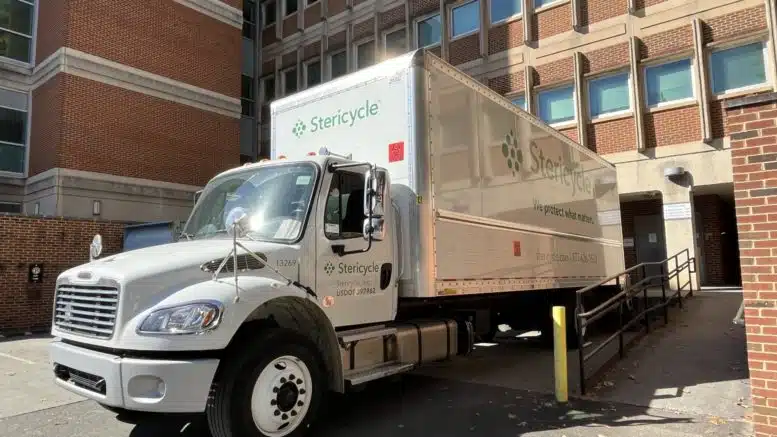By Will Atwater
Three years ago, Trenton Ford was excited to serve his community as a new parks employee. However, along the way, he started to notice something.
“When I signed on to become an Alamance County Parks employee, I swore an oath to protect the environment and the people who live within [the county],” he said at a recent public meeting. “It is clear as day to see that there are billion-dollar corporations that are here, and they are making money hand over fist because of a lack of oversight and communication and involvement with local people.”
The corporation Ford alluded to is Stericycle Inc.
Roughly a mile from where the public hearing, sponsored by the North Carolina Department of Environmental Quality, Division of Air Quality, was held in August, Stericycle operates a medical waste facility that critics say needs more operational oversight to protect local air quality.
This criticism comes as public scrutiny grows of the thorny problem of medical waste and how to dispose of it without adding more carbon emissions and other hazardous substances into the atmosphere.
Last week, the state of Maryland fined a medical incinerator $1.75 million for “exposing the public to biohazardous material,” according to ABC News.
Representing Mebane’s West End Revitalization Association, a nonprofit community advocacy organization, Omega Wilson was one of approximately 50 people who attended the public hearing at Alamance Community College to offer comments on a new air quality permit for Stericycle.
Wilson has become intimately familiar with the facility. Recently, he and his wife, Brenda Wilson, collaborated with environmental justice leaders, medical professionals and university professors to craft a policy statement.

Credit: Joseph Navin
“Stericycle’s violation of the Clean Air Act places disproportionate health burdens on impacted residents,” Wilson said at the August meeting.”It affects respiratory health, medical costs and lost school and workdays.
“That waste includes garbage generated by facilities — primarily laboratories, research centers, homes, communities [and] veterinary health care settings.”
The problem is that there’s too much medical waste. Muddled waste streams result in lots of other garbage — paper and other nonregulated medical waste — to end up in bags with stuff that needs to be burned because they are potentially contaminated by blood, body fluids or other infectious materials.
And the stuff that needs incinerating creates hazards when you incinerate it in facilities such as Stericycle.
The root problem
On average, U.S. hospitals produce 29 pounds of medical waste (including landfill waste, regulated medical waste, pharmaceutical waste, hazardous waste and recycling) per staffed bed daily, according to Practice Greenhealth. The nonprofit organization works with hospitals and health care systems to develop environmentally sustainable and equitable practices.
The problem is enormous. According to the American Hospital Association, there are roughly 919,649 staffed beds in U.S. hospitals. All those American hospitals end up generating more than 13,000 tons of waste daily — more than 4 million tons each year.
One of the challenges hospitals face is making sure that regular waste is not thrown in with regulated medical waste, also known as “red bag waste,” said Kathleen Shapley-Quinn, executive director of Carolina Advocates for Climate Health and Equity, a nonprofit organization that helps medical professionals understand the health impact of climate change.
“If there’s not a lot of clarity around what red bag waste is by definition, then it’s super easy for anybody to say, ‘Oh, this band-aid has blood on it. Let me throw that out,’” Shapley-Quinn said.
The confusion around what qualifies as red-bag waste results in improper disposal of nonregulated medical waste, she said, which adds to that annual tally.
“You throw [the waste] in the incinerator, and you burn it,” Shapley-Quinn said, “creating all these toxins. And if only 50 percent of what’s in that red bag is regulated medical waste, you’re creating a lot of heat and toxins when it’s not needed.”
Further increasing the potential for nonregulated medical waste to end up at an incinerator is that many of the products used in hospitals daily have expiration dates on them. Once a wooden tongue suppressor or a cotton swab exceeds its expiration date, it gets tossed.
This approach also applies to pharmaceuticals and instruments such as a harmonic scalpel, used in surgery to cut and cauterize wounds, and small medical grade scissors.
Ways to reduce medical waste
Adelaide Cooke is a third-year medical student at the UNC Chapel Hill School of Medicine. She’s committed to combating climate change by exploring ways to reduce medical waste that ends up in landfills or incinerators, which, she notes, can lead to increased greenhouse gas emissions, as well as the release of other toxins into the atmosphere.
Cooke is a member of a group of medical students who conducted a waste audit at one of the medical school clinics to figure out how the clinic’s staff was handling recycling and waste collection. The waste audit revealed that recycling and trash bins often contain a percentage of materials that didn’t belong.
“We started correctly separating the waste so you would do all of these measurements and observations with the waste as it was,” Coke said. “And then, in the trash, if we saw recycling, we would take all of the recyclable items out […] and then would weigh the recycling material in the trash and then calculate the percentage of stuff that was discarded incorrectly.”
Hospitals and other health care facilities usually pay by weight for recycling and waste removal services, so a waste audit can be used to identify problems in waste streams, educate employees about best practices and reduce costs by ensuring that waste is properly sorted.
Another idea catching on is collecting and redistributing single-use equipment, such as tongue suppressors, with an expiration date so that they don’t get summarily tossed into the trash.


“We have this very strict regulatory system designed to protect patient safety [..] for infection control, but that has led to a system that uses a lot of what’s designated as single-use items,” said John Lohnes, a retired physician assistant and part time instructor at the Duke University School of Medicine.
Aside from his teaching responsibilities, Lohnes is the director of REMEDY. The volunteer program seeks to repurpose single-use items that may have surpassed their expiration date but have never been used and are safe to donate to hospital systems in need.
In a warehouse on Duke’s campus, Lohnes and a team of volunteers sort items donated from the hospital system and prepare them to ship to a facility in need. The cost of shipping is covered by the organization receiving the supplies.
In addition to redistributing safe, unused medical items, another process that aims to reduce medical waste is repurposing instruments that can be sterilized and repackaged. The challenge with this process is medical systems want to avoid taking on the added work of sterilization and the liability issues that could occur from passing on used equipment, even though it’s been sterilized.
That’s the case, even though, “when you see a reprocessed device, the hospital pays about 30 to 50 percent of what they would pay for a new device,” said Daniel Vukelich, president of the Association of Medical Device Reprocessors.
In 2021, hospitals that participated in the reprocessing program collectively saved more than $400 million by purchasing used instruments, according to the medical waste reprocessor. Advocates say that the savings numbers will likely make more hospital systems consider the program.
Sign up for our Newsletter
“*” indicates required fields
Air quality concerns
Meanwhile, Stericycle is one of just four companies that treat medical waste in the state. The company operates the state’s only incinerator and one autoclave — medical equipment sterilization — facility.
Between 2019 and June 2023, Stericycle’s pollution control equipment failed 17 times, allowing emissions to escape into the atmosphere. Some of those failures allowed toxins such as nitric oxide, sulfur oxides and carbon dioxide to escape into the environment around the plant.
As a result, Stericycle was fined $65,000 by the Department of Environmental Quality’s Division of Air Quality. The company was also compelled to enter into a consent order with the division and agreed to upgrade its equipment to reduce the occurrence of emissions. Additionally, Stericycle is operating under an emissions plan developed by the state regulator intended to better monitor what comes out of its smokestack.
Between 2021 and 2022, in-state medical waste facilities treated 26,799.48 tons of medical waste. North Carolina generated 17,117.15 tons of that amount, and out-of-state waste accounted for the rest, according to NCDEQ’s Consolidated Waste Report.
Valued at $4 billion, Stericycle reported in an email that it alone treated 7,500 tons of medical waste and 424.5 tons of pharmaceutical waste in 2022.
Stericycle critics like Haw River Riverkeeper Emily Sutton don’t deny that the company provides an essential service. But she wants to protect the local community’s air quality.
“When a river is threatened, we can choose to stay out of the water. We can buy bottled water if we must,” Sutton said. “When our air is threatened, we can’t avoid breathing in particulate matter and toxins that go into the air and float back down to the ground and into the soil, the groundwater and the surface water.”
In August, the Southern Environmental Law Center wrote to NCDEQ’s Division of Air Quality on behalf of several environmental advocacy groups, including the West End Revitalization Association, Haw River Assembly and the NC Environmental Justice Network.
The letter was in response to a proposed draft air quality permit. In the letter, SELC claims that Stericycle “has polluted the air and waterways and harmed the health and well-being of the nearby Alamance County communities surrounding it.”
SELC listed actions it says that state regulators should take to protect Alamance County residents from being exposed to further contamination and to hold Stericycle accountable.
The recommendations include:
- Installing a smokestack filtration system to capture emissions from the waste incineration process and prevent them from escaping into the atmosphere.
- Conduct a comprehensive baseline study of ambient air quality, including strategically positioned air quality monitoring stations near the facility.
- Require PFAS testing and include emissions prohibition and/or a reopener for necessary limits in the final permit.
- Address the loophole allowing uncontrolled emissions during “bypass” events by continuous monitoring and regulation of emissions.
- Prioritize the well-being of the community by allocating a portion of Stericycle-generated profits to mitigate cumulative impacts through arrangements like community-based agreements.
In response, Stericycle released a statement that reads in part:
“Stericycle… [has] made significant investments to meet and exceed the EPA emissions standards for our facilities.
“We look forward to demonstrating our dedication to operating in a safe, responsible, and sustainable manner as we serve the healthcare community in this region and across all communities where we operate.”
Stericycle’s air quality permit renewal is being considered, and a decision is expected after the 45-day window to evaluate its status ends.












